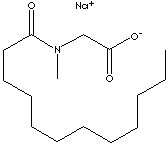PRODUCT IDENTIFICATION

3402.11
H.S. CODE
TOXICITY
CLASSIFICATION
SURFACTANTS /
PHYSICAL AND CHEMICAL PROPERTIES
MELTING POINT
SOLUBILITY IN WATER
REFRACTIVE INDEX
94 C (30%)
GENERAL DESCRIPTION AND APPLICATIONS
30% SOLUTION
APPEARANCE
ACTIVE MATTER
30.0% min
pH
7.5 - 8.5 (10% Sol.)
SODIUM SOAP
2.0% max
COLOR ( APHA)
60 max
94% POWDER
APPEARANCE
ACTIVE MATTER
94.0% min
pH
7.5 - 8.5 (10% Sol.)
SODIUM SOAP
4.0% max
COLOR ( APHA)
80 max (20% Sol.)
GENERAL DESCRIPTION OF IONIC SURFACTANTS
Ionic surfactants which contain hydrophobic hydrocarbon group connected with one or several hydrophilic groups dissociate into a positively charged cation and a negatively charged anion in an aqueous solution. If the head is negatively charged to carry the surface active properties, it is called anionic surfactant, whereas a positively charged head is the carrier of the surface active properties in cationic surfactants. Typically cationic surfactants are based on the nitrogen atom carrying the cationic charge such as amine and quaternary ammonium product.
Cationic surfactant is considered to be poor cleaners but it contributes to the fabric softening, the disinfecting properties, and the grease-water interfacial tension reducing. Cationic surfactants include quaternary ammonium compounds, amines (primary, secondary, tertiary, diamines, polyamines, amine salts), imidazoline compounds, betaine compounds, and esterquats.
Anionic surfactant is the widely used type of surface active agent for laundry detergents, liquid cleaners and shampoos due to excellent cleaning properties particularly effective at oily soil cleaning and oil/clay soil suspension. Anionic surfactants are deactivated in many hard water. To prevent deactivation, builders should be dosed. Anionic surfactant is used as a emulsifier in cosmetics, tooth paste, cream, shampoo, and acrylic binder. Common soap is an anionic surfactant. Carboxylate, sulfate, sulfonate and phosphate are the polar groups in anionic surfactants. Anionic surfactants include alkyl benzene sulfonate, fatty acid salts, sodium lauryl sulfate, alkyl sulfate salts, sodium lauryl ether sulfate, alpha-olefin sulfonates, phosphate esters, sulphosuccinates, alkyl phenol ether sulfates, and isethionates.